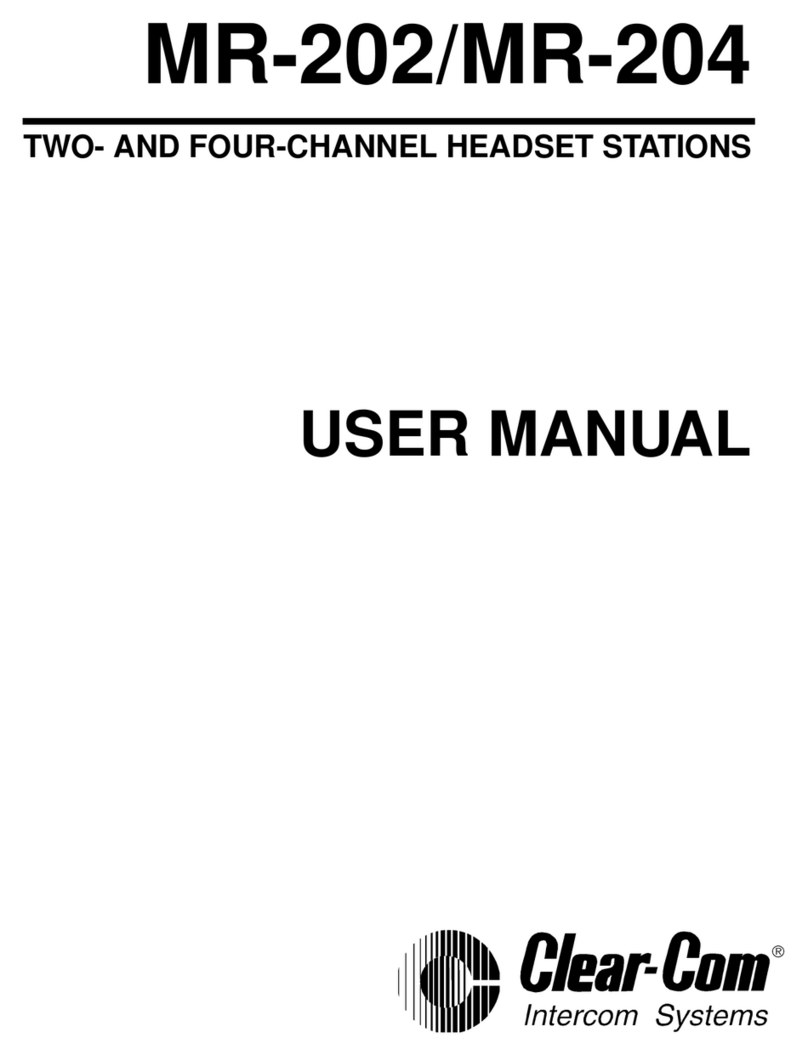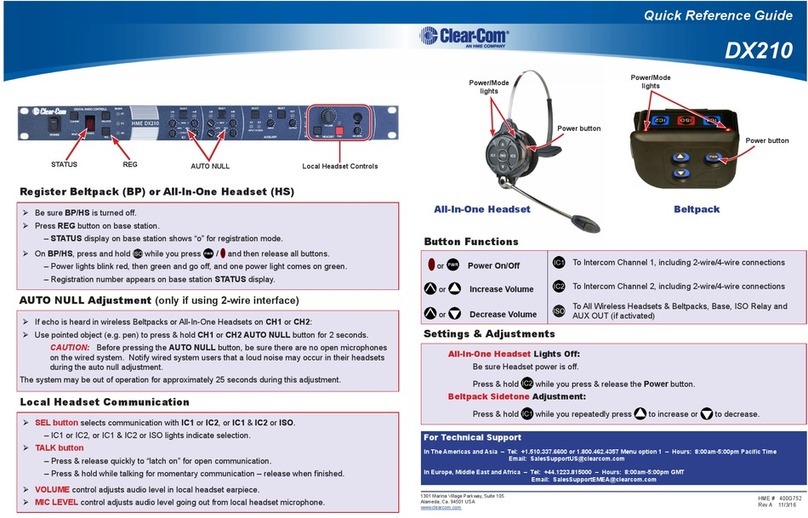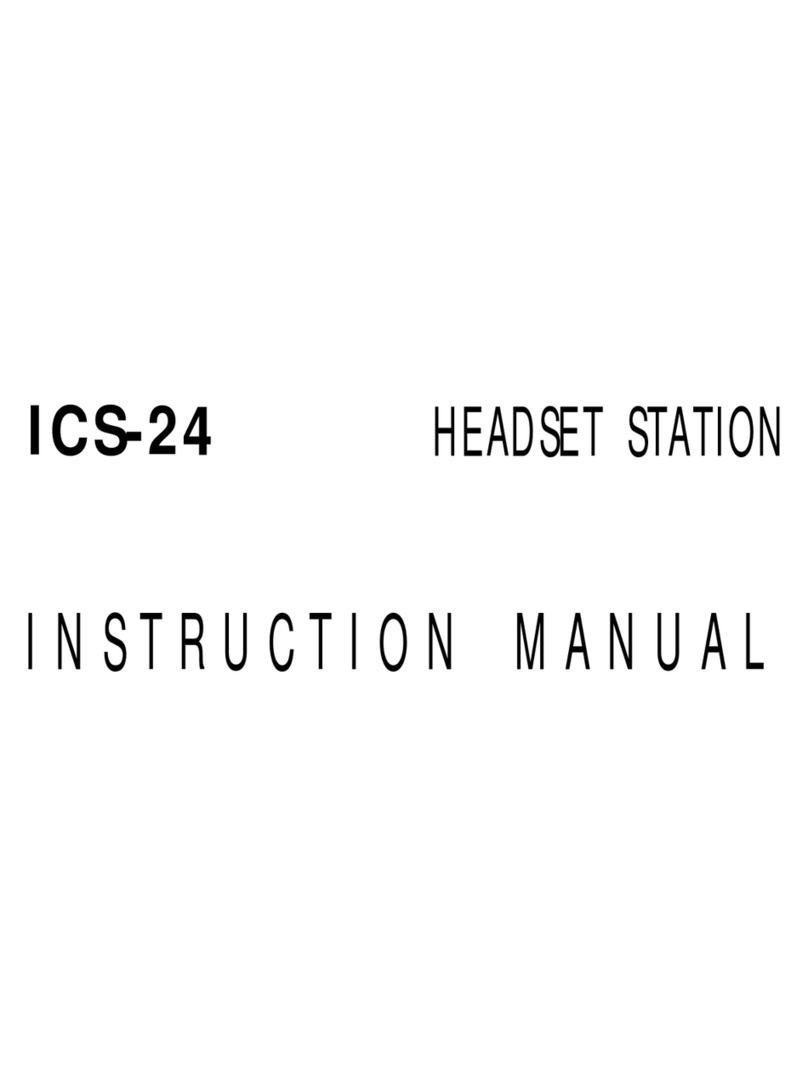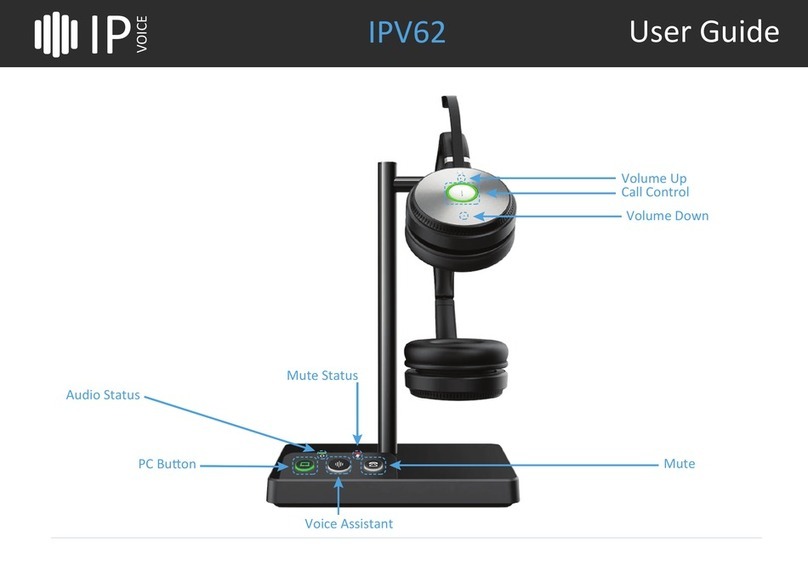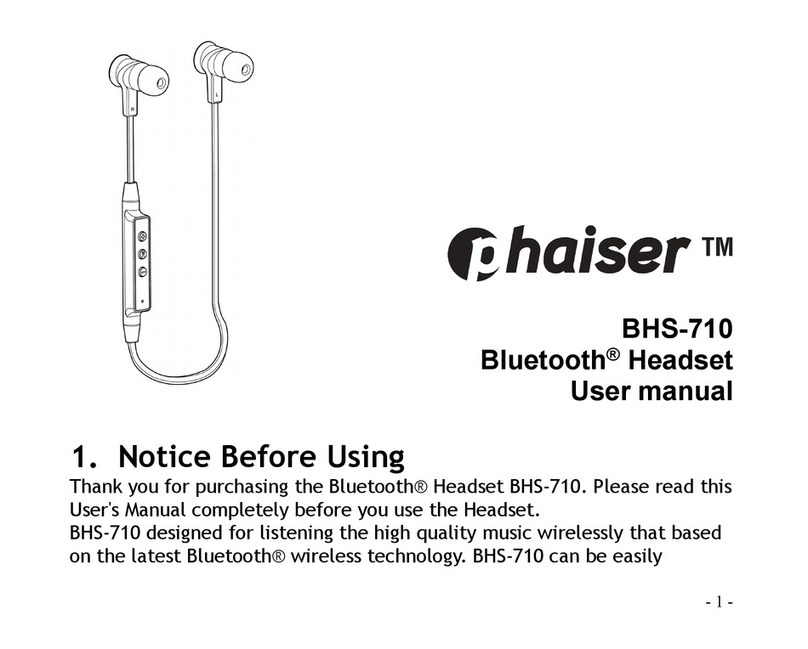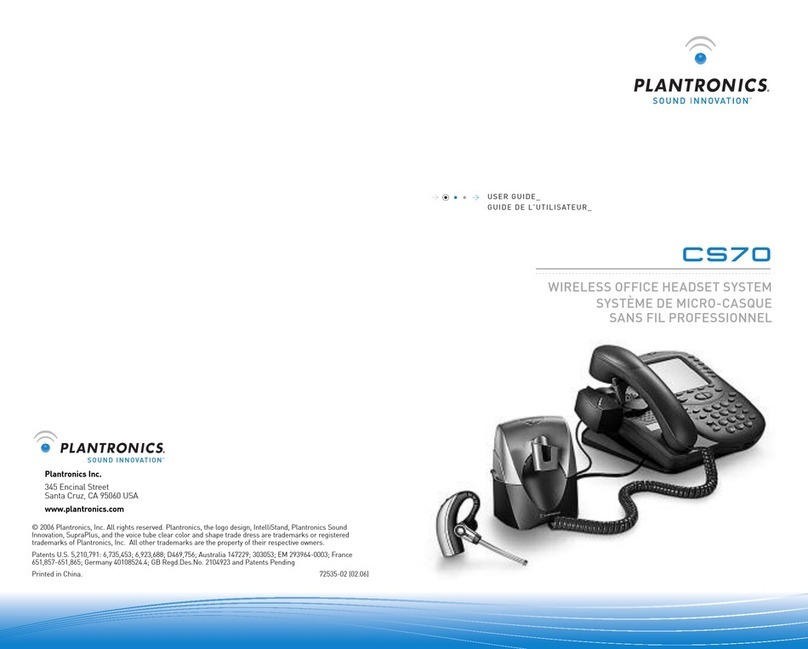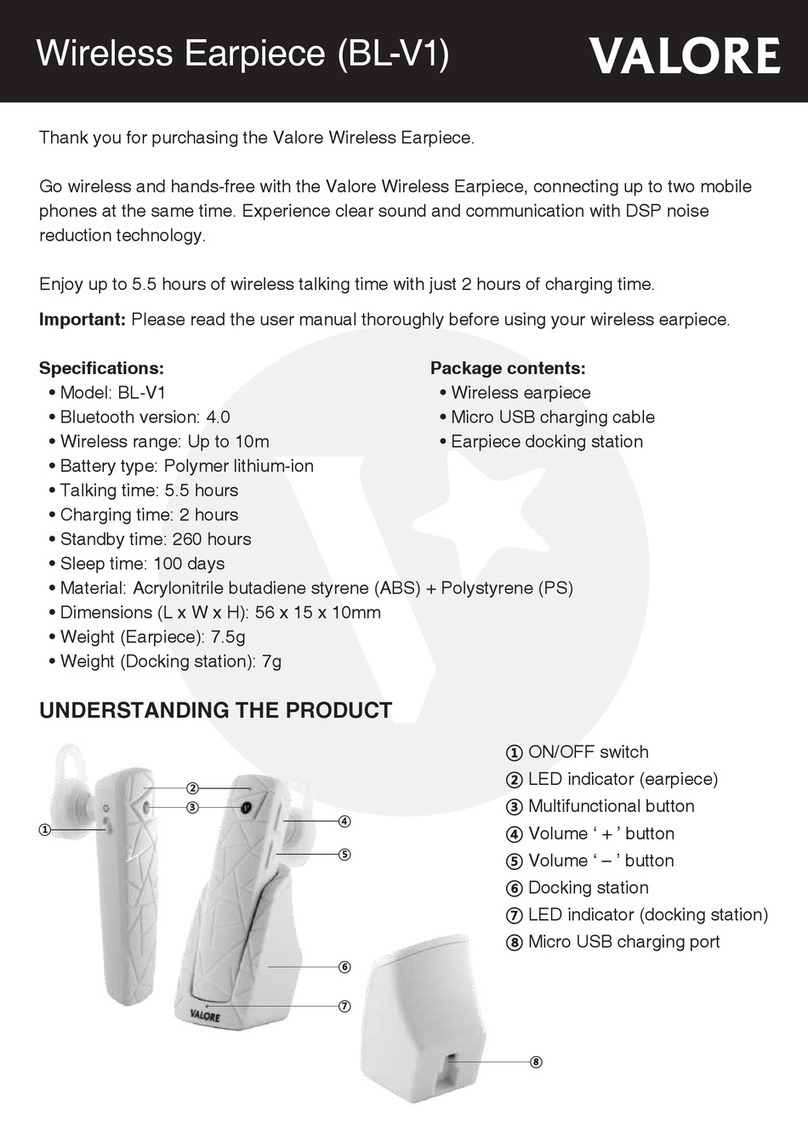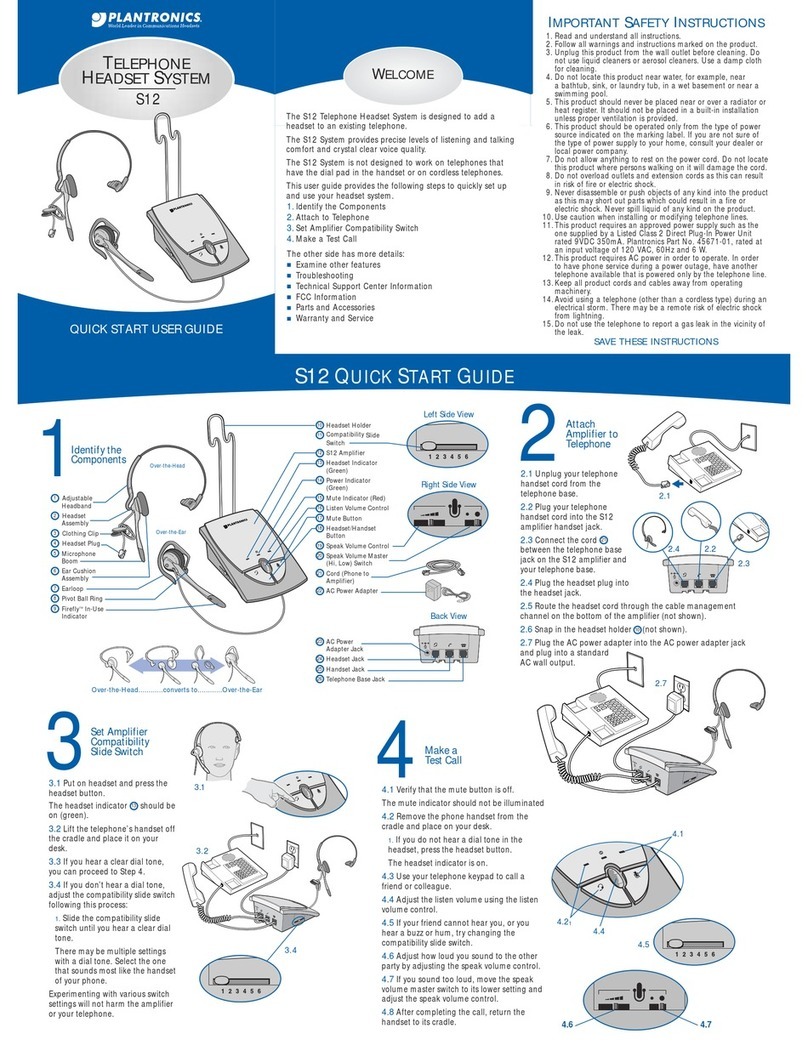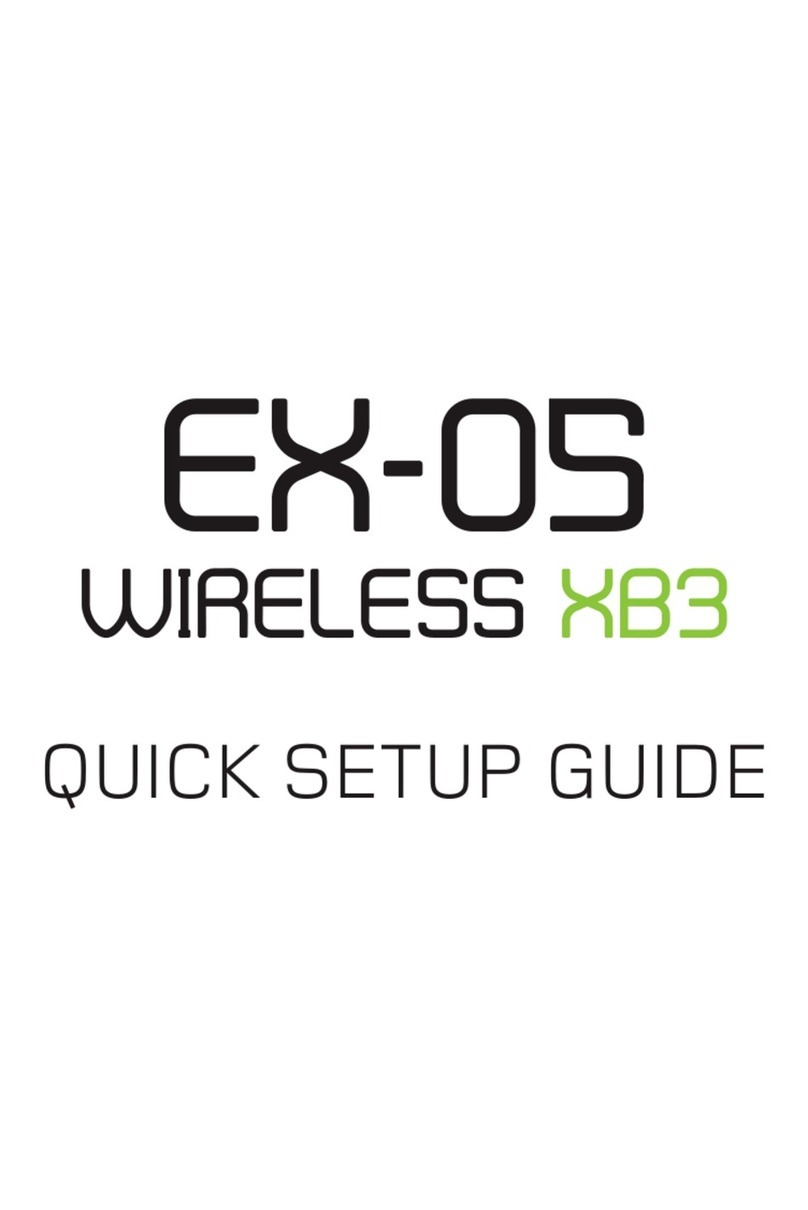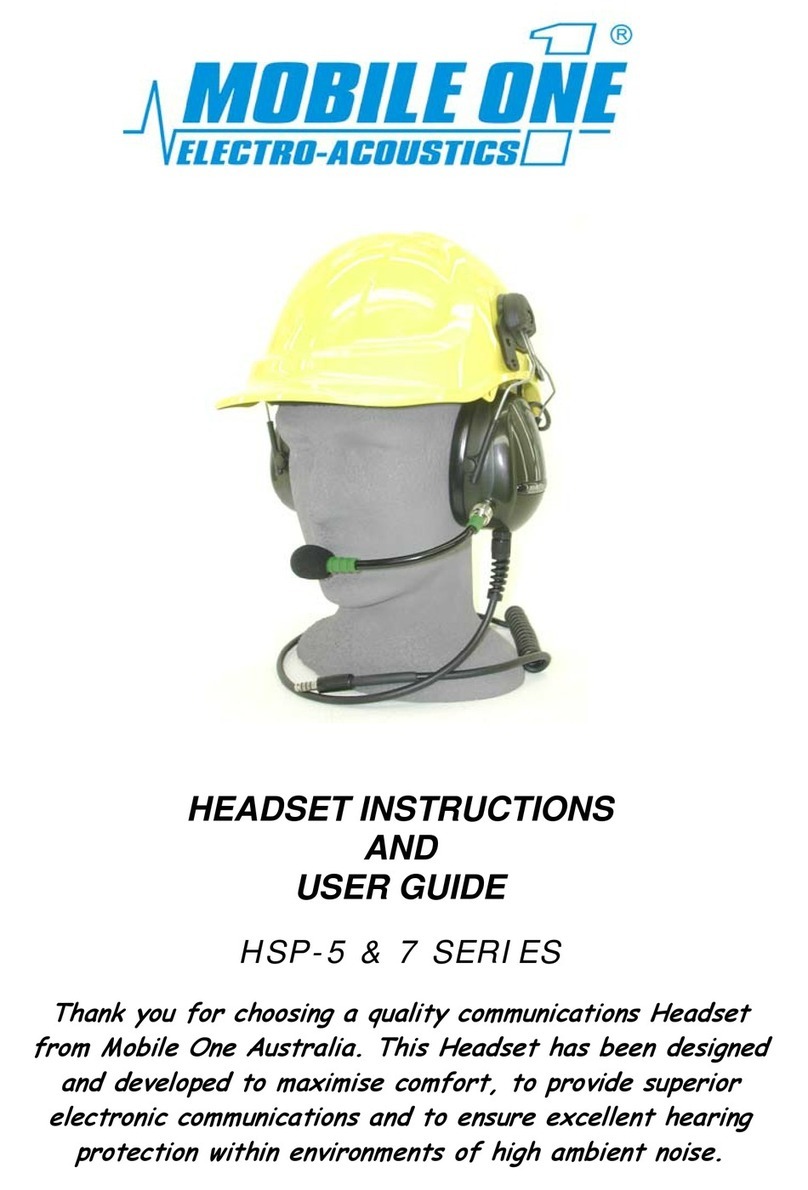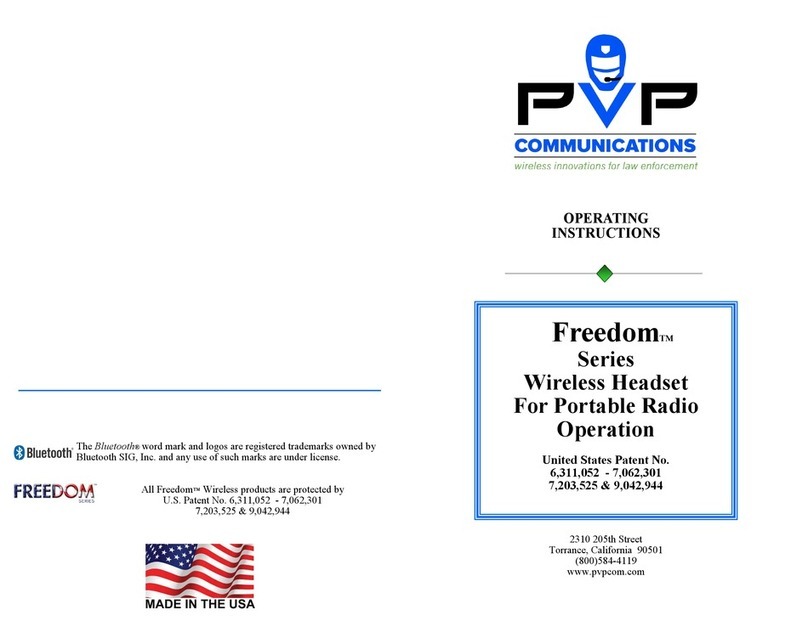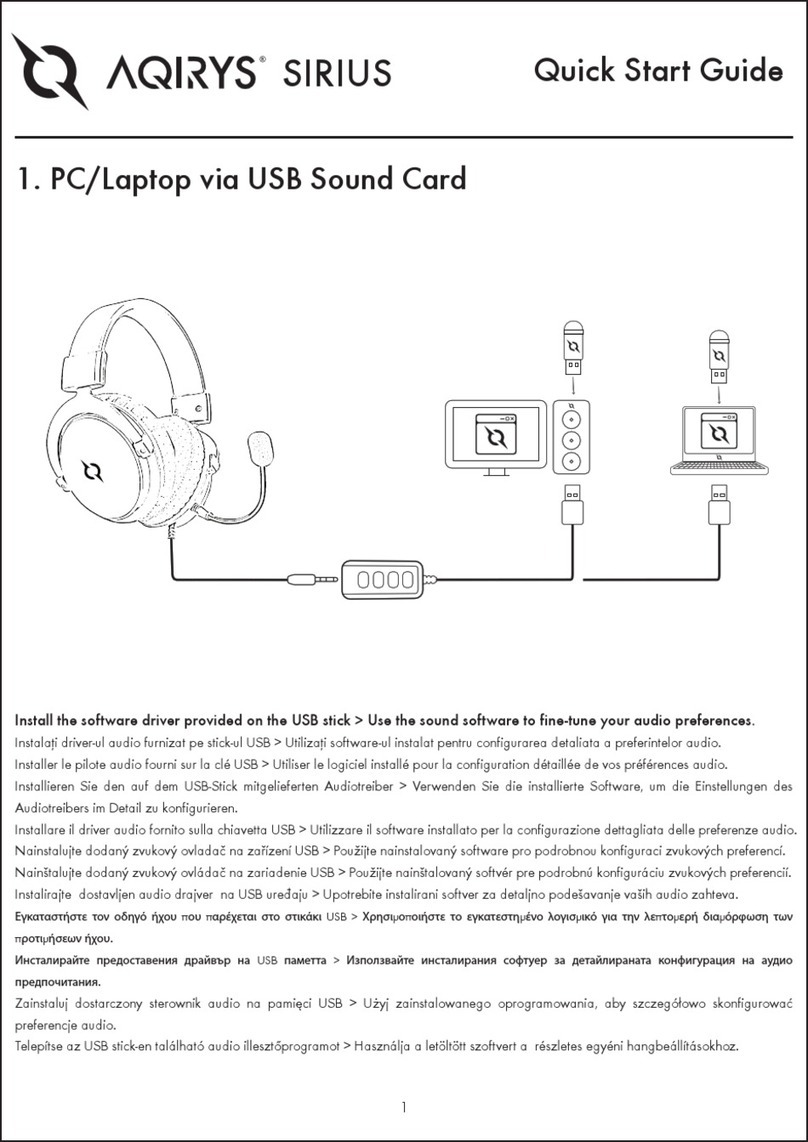Clear-Com ENCORE RM-702 User manual

RM-702 TWO-CHANNEL REMOTE STATION
INSTRUCTION MANUAL
CLEAR-COM ENCORE

RM-702 Two-Channel Remote Station Instruction Manual
Part Number 810343Z Rev. 4
Legal Disclaimer
Copyright © 2013 HME Clear-Com Ltd.
All rights reserved.
Clear-Com, the Clear-Com logo, and Clear-Com Concert are trademarks or registered trademarks of HM Electronics, Inc.
The software described in this document is furnished under a license agreement and may be used only in accordance with the
terms of the agreement.
The product described in this document is distributed under licenses restricting its use, copying, distribution, and decompilation/
reverse engineering. No part of this document may be reproduced in any form by any means without prior written authorization
of Clear-Com, an HME Company.
Clear-Com Offices are located in California, USA; Cambridge, UK; Montreal, Canada; and Beijing, China. Specific addresses
and contact information can be found on Clear-Com's corporate website:
www.clearcom.com
Clear-Com Contacts
Americas and Asia-Pacific Headquarters
California, United States
Tel: +1.510.337.6600
Email: CustomerServ[email protected]
Europe, Middle East, and Africa Headquarters
Cambridge, United Kingdom
Tel: +44 1223 815000
Email: [email protected]
Canada Office
Quebec , Canada
Tel: +1 (450) 653-9669
China Office
Beijing Representative Office
Beijing, P.R.China
Tel: +8610 65811360 / 65815577

RM-702 TWO-CHANNEL REMOTE STA- i
CONTENTS
OPERATION . . . . . . . . . . . . . . . . . . . . . . . . . . . . . . . . . . 1-1
Introduction . . . . . . . . . . . . . . . . . . . . . . . . . . . . . . . . . . . . . . . . . . . . . . . . . 1-1
The Clear-Com Concept. . . . . . . . . . . . . . . . . . . . . . . . . . . . . . . . . . . . . . . . 1-1
Description . . . . . . . . . . . . . . . . . . . . . . . . . . . . . . . . . . . . . . . . . . . . . . . . . . 1-2
Operation . . . . . . . . . . . . . . . . . . . . . . . . . . . . . . . . . . . . . . . . . . . . . . . . . . . 1-2
Talk Buttons . . . . . . . . . . . . . . . . . . . . . . . . . . . . . . . . . . . . . . . . . . . . . . . 1-3
Call Buttons . . . . . . . . . . . . . . . . . . . . . . . . . . . . . . . . . . . . . . . . . . . . . . . 1-4
Volume Controls. . . . . . . . . . . . . . . . . . . . . . . . . . . . . . . . . . . . . . . . . . . . 1-4
SideTone Controls . . . . . . . . . . . . . . . . . . . . . . . . . . . . . . . . . . . . . . . . . . 1-4
Program Send Level Control for Channel A and B . . . . . . . . . . . . . . . . . 1-4
Speaker On/Off Switch . . . . . . . . . . . . . . . . . . . . . . . . . . . . . . . . . . . . . . 1-4
Mic Select Switch. . . . . . . . . . . . . . . . . . . . . . . . . . . . . . . . . . . . . . . . . . . 1-4
Program Monitor Level Control. . . . . . . . . . . . . . . . . . . . . . . . . . . . . . . . 1-4
Announce Button . . . . . . . . . . . . . . . . . . . . . . . . . . . . . . . . . . . . . . . . . . . 1-5
INSTALLATION . . . . . . . . . . . . . . . . . . . . . . . . . . . . . . . 2-1
Installation Overview . . . . . . . . . . . . . . . . . . . . . . . . . . . . . . . . . . . . . . . . . . 2-1
Intercom Line Connection . . . . . . . . . . . . . . . . . . . . . . . . . . . . . . . . . . . . 2-1
Connecting or Isolating RM-702 Channels . . . . . . . . . . . . . . . . . . . . . . . 2-1
Line Termination . . . . . . . . . . . . . . . . . . . . . . . . . . . . . . . . . . . . . . . . . . . 2-3
Station Powering . . . . . . . . . . . . . . . . . . . . . . . . . . . . . . . . . . . . . . . . . . . 2-3
Cable Considerations . . . . . . . . . . . . . . . . . . . . . . . . . . . . . . . . . . . . . . . . 2-3
Description of Front panel Connectors . . . . . . . . . . . . . . . . . . . . . . . . . . . . 2-4
Headset Connector (Front Panel) . . . . . . . . . . . . . . . . . . . . . . . . . . . . . . . 2-4
Panel Mic Connector (Front Panel) . . . . . . . . . . . . . . . . . . . . . . . . . . . . . 2-4
Description of Rear Panel Connectors . . . . . . . . . . . . . . . . . . . . . . . . . . . . . 2-5
Intercom Line Connectors
(Rear Panel, XLR-3 2 Male & 2 Female) . . . . . . . . . . . . . . . . . . . . . . . . . . 2-5
IFB/Hot Mic (Rear Panel, 1/4-Inch Phone Jack) . . . . . . . . . . . . . . . . . . . 2-5
Accessory (Rear Panel, DB-15F) . . . . . . . . . . . . . . . . . . . . . . . . . . . . . . . 2-6
Description of Options and Adjustments . . . . . . . . . . . . . . . . . . . . . . . . . . . 2-6
DIP Switch Option Switches (Rear Panel). . . . . . . . . . . . . . . . . . . . . . . . 2-6
Re-Setting Program Interrupt Options . . . . . . . . . . . . . . . . . . . . . . . . . . . 2-8
Panel Mic Level Adjustment (Internal) . . . . . . . . . . . . . . . . . . . . . . . . . . 2-9
Intercom Line Length Compensation (Rear-Panel DIP Switches) . . . . 2-10
Program Feed on Announce. . . . . . . . . . . . . . . . . . . . . . . . . . . . . . . . . . 2-10
Typical System Applications . . . . . . . . . . . . . . . . . . . . . . . . . . . . . . . . . . . 2-11
ENG/EFP Truck . . . . . . . . . . . . . . . . . . . . . . . . . . . . . . . . . . . . . . . . . . . 2-11
Cable/School Television Studio . . . . . . . . . . . . . . . . . . . . . . . . . . . . . . . 2-12
Actual Applications . . . . . . . . . . . . . . . . . . . . . . . . . . . . . . . . . . . . . . . . . . 2-12

RM-702 TWO-CHANNEL REMOTE STATION
ii
Intercom line wiring . . . . . . . . . . . . . . . . . . . . . . . . . . . . . . . . . . . . . . . . 2-13
Program Input. . . . . . . . . . . . . . . . . . . . . . . . . . . . . . . . . . . . . . . . . . . . . 2-14
Internal IFB Operation . . . . . . . . . . . . . . . . . . . . . . . . . . . . . . . . . . . . . . 2-16
External IFB (MA-704 and PIC-4704 Connection). . . . . . . . . . . . . . . . 2-16
PA Feed to Studio Output. . . . . . . . . . . . . . . . . . . . . . . . . . . . . . . . . . . . 2-17
Remote Control of Talk Switches . . . . . . . . . . . . . . . . . . . . . . . . . . . . . 2-18
Inadequate Side-tone Adjustment . . . . . . . . . . . . . . . . . . . . . . . . . . . . . 2-18
MAINTENANCE . . . . . . . . . . . . . . . . . . . . . . . . . . . . . . . 3-1
Introduction . . . . . . . . . . . . . . . . . . . . . . . . . . . . . . . . . . . . . . . . . . . . . . . . . 3-1
TECHNICAL SPECIFICATIONS . . . . . . . . . . . . . . . . . . 4-1
RM-702 Two-Channel Station . . . . . . . . . . . . . . . . . . . . . . . . . . . . . . . . . . . 4-1
LIMITED WARRANTY. . . . . . . . . . . . . . . . . . . . . . . . . . 5-I
Warranty Period . . . . . . . . . . . . . . . . . . . . . . . . . . . . . . . . . . . . . . . . . . . . . . 5-i
Technical Support. . . . . . . . . . . . . . . . . . . . . . . . . . . . . . . . . . . . . . . . . . . . . 5-i
Warranty Repairs and Returns . . . . . . . . . . . . . . . . . . . . . . . . . . . . . . . . . . . 5-ii
Non-Warranty Repairs and Returns . . . . . . . . . . . . . . . . . . . . . . . . . . . . . . . 5-ii
Extended Warranty . . . . . . . . . . . . . . . . . . . . . . . . . . . . . . . . . . . . . . . . . . . . 5-ii
Service Contract . . . . . . . . . . . . . . . . . . . . . . . . . . . . . . . . . . . . . . . . . . . . . 5-iii
Liability . . . . . . . . . . . . . . . . . . . . . . . . . . . . . . . . . . . . . . . . . . . . . . . . . . . 5-iii

RM-702 TWO-CHANNEL REMOTE STATION iii
IMPORTANT SAFETY
INSTRUCTIONS
1. Read these instructions.
2. Keep these instructions.
3. Heed all warnings.
4. Follow all instructions.
5. Do not use this apparatus near water.
6. Clean only with dry cloth.
7. Do not block any ventilation openings. Install in accordance with the
manufacturer’s instructions.
8. Do not install near any heat sources such as radiators, heat registers,
stoves, or other apparatus (including amplifiers) that produce heat.
9. Only use attachments/accessories specified by the manufacturer.
10. Use only with the cart, stand, tripod, bracket, or table specified by the
manufacturer, or sold with the apparatus. When a cart is used, use caution
when moving the cart/apparatus combination to avoid injury from
tip-over.
11. Unplug this apparatus during lightning storms or when unused for long
periods of time.
12. Refer all servicing to qualified service personnel. Servicing is required
when the apparatus has been damaged in any way, such as power-supply
cord or plug is damaged, liquid has been spilled or objects have fallen into
the apparatus, the apparatus has been exposed to rain or moisture, does
not operate normally, or has been dropped.
13. WARNING: To reduce the risk of fire or electric shock, do not expose
this product to rain or moisture.
Please familiarize yourself with the safety symbols in Figure 1. When you
see these symbols on this product, they warn you of the potential danger
of electric shock if the station is used improperly. They also refer you to
important operating and maintenance instructions in the manual.
Please read and follow
these instructions before
operating this product.

RM-702 TWO-CHANNEL REMOTE STATION
iv
Figure 1: Safety Symbols
EMC AND SAFETY
The RM-702 station meets all relevant CE and FCC specifications set out
below:
EN55103-1 Electromagnetic compatibility. Product family standard for
audio, video, audio-visual, and entertainment lighting control apparatus
for professional use. Part 1: Emissions.
EN55103-2 Electromagnetic compatibility. Product family standard for
audio, video, audio-visual, and entertainment lighting control apparatus
for professional use. Part 2: Immunity.
And thereby compliance with the requirement of Electromagnetic
Compatibility Directive 2004/108/EC and Low Voltage Directive
2006/95/EC
This device complies with Part 15 of the FCC Rules. Operation is subject
to the following two conditions: (1) this device may not cause harmful
interference, and (2) this device must accept any interference received,
including interference that may cause undesired operation.
CAUTION
RISK OF ELECTRIC SHOCK
DO NOT OPEN
This symbol alerts you to the presence of uninsulated dangerous
voltage within the product's enclosure that might be of sufficient
magnitude to constitute a risk of electric shock.Do not open
the product's case.
This symbol informs you that important operating and main-
tenance instructions are included in the literature accompanying
this product.

RM-702 TWO-CHANNEL REMOTE STA- 1-1
OPERATION
INTRODUCTION
Congratulations on choosing this Clear-Com product. Clear-Com was
established in 1968 and remains the market leader in providing intercomsfor
entertainment, educational, broadcast, and industrial applications. The
ruggedness and high build-quality of Clear-Com products defines the industry
standard. In fact, many of our original beltpacks and main stations are still in
daily use around the world.
THE CLEAR-COM CONCEPT
Clear-Com is a closed-circuit intercom system that consistently provides
high-clarity communication in high-noise and low-noise environments. A
basic system consists of a single- or multi-channel power supply or main
station connected to various single- or multi-channel remote stations, such as
beltpacks and loudspeaker stations.
Clear-Com manufactures a wide variety of both portable and
fixed-installation units. All are compatible with each other. Clear-Com
intercom systems can also interface with other communication systems and
devices.
Clear-Com stations are interconnected with two-conductor, shielded
microphone cable, using 3-pin XLR connectors. One wire carries the DC
power from a main station or power supply to all remote stations, and the
other wire carries two-way (duplex) audio information. The shield acts as a
common ground. One termination (per channel) is needed throughout the
intercom network, and is usually located in the main station or power supply.
Clear-Com is a distributed amplifier system; each main and remote station
houses its own mic preamplifier, headset or speaker power amplifier, and
signaling circuitry. Low-impedance mic input lines and specially designed
circuitry make Clear-Com channels virtually immune to RFI and dimmer
noise.
Clear-Com main stations, power supplies and certain remote stations have
auxiliary program inputs with local volume control, allowing an external
audio source to be fed to the intercom system.
Visual signal circuitry (call lights), a standard feature on most main and
remote stations, allows the user to attract the attention of operators who have
removed their headsets.
Depending on the type of main and remote stations selected (and assuming
that enough DC power is available) remote stations can be distributed along a
mile of wire. Remote stations bridge the intercom line at a very high
impedance and place a minimum load on the line. The audio level always

RM-702 TWO-CHANNEL REMOTE STATION
1-2
remains constant, and does not fluctuate as stations leave and join the
network.
DESCRIPTION
The RM-702 is one of a series of professional intercom stations specifically
designed for the broadcast industry. This two-channel, one-rack-space station
is ideal for ENG and EFP trucks, production studio consoles, and small TV
facilities. The station can be tailored to your needs through its programmable
talk button options. The RM-702 is compatible with all Clear-Com party-line
intercoms.
The station also incorporates an internal single-channel program interrupt
system (IFB). When activated, one or more stations can interrupt the program
to a talent with Clear-Com’s wired or wireless talent receivers. Direct
connection to Clear-Com’s IFB system is easily accomplished through a 1/4
in. (0.62 cm) phone jack on the rear panel intended to directly connect to a
Clear-Com MA-704.
The RM-702 remote speaker/headset station allows selectable two-channel
talking and/or listening on a Clear-Com intercom system. The operator can
communicate on either of the channels separately or on both at once.
Illuminated dual-action talk buttons provide electronic momentary or latching
capability. The latching feature may be disabled if desired. The talk buttons
can also be remote controlled for footswitch or other use. Monitoring activity
is possible through the speaker or headset or both at once.
The RM-702 features visual call signaling to attract the attention of operators
who have removed their headsets or turned off their speakers.
This station accepts dynamic headsets. The station accepts two different
lengths of plug-in gooseneck microphones, 9 in. (22.86 cm) and 18 in. (45.72
cm), to allow for different operating locations/positions.
The station’s speaker can be turned on or off by a convenient front panel
switch when private conversation via the headset is desired. A speaker
dipping circuit provides an additional amount of acoustic output before
feedback. This feature helps to reduce feedback when stations are placed in
close proximity to each other. The station accepts a balanced program input
for monitoring external audio in the headset or speaker. Individual sidetone
controls for each channel allow the operator to vary the level of his/her own
voice as heard in the headset/speaker.
Studio announce allows control of a paging speaker in a studio. A front panel
button activates this function and an associated relay.
The RM-702 installs in a standard 19 in. (48.26 cm) equipment rack, using
only one rack space. The station provides two 3-pin, XLR connectors for
input and loop-through on each channel.

RM-702 TWO-CHANNEL REMOTE 1-3
OPERATION
Normal operation of the RM-702 requires access only to the front panel
controls. For intercom operation, set the listen level controls for each channel
to the desired level and press the talk switches when talking. If a headset is
being used, set the sidetone control for the receiving channel for the desired
amount of sidetone in the earphone. If the panel mic and speaker are being
used, set the sidetone control for minimum feed-through to the speaker to
prevent feedback.
Figure 1-1: RM-702 Front Panel
The rest of this section is a detailed description of each control.
TALK BUTTONS
Each channel has its own illuminated talk button for activating the
microphone feed to a given channel. Mechanically, the pushbutton is
momentary in action; however, electrically the button has dual action
(momentary or latching) depending on how the button is pressed. The latching
function can be defeated with a rear-panel DIP switch.
•LATCHING: Pressing the button quickly will toggle the talk function,
alternately turning it on or off.
•MOMENTARY: Pressing the button for longer than 1/4 second will turn
the button press into a momentary function such that when the button is
released the talk function will turn off. In any case the talk function is
activated all of the time the button is pressed.
•TALK INDICATION: The talk button illuminates yellow when a talk is
activated and blue when talk is not active.
•CALL INDICATION: The call button will flash red when a call signal
is received on that channel.
•AUTO-CALL ON TALK: Each channel can be set to send a call signal
when the talk function is active. This function is used to activate IFB
circuits or any other call-activated function available on other stations. A
DIP switch on the rear panel activates this function.
Panel Mic
Speaker
Program
Level
On
Off
Sidetone
Null Level
Announce
Level
ProgramProgram
Channel A Channel B
Sidetone
Null
Volume
Vol ume
Talk
Headset
Panel Mic
Headset
2-Channel
Remote Station
RM-702
Call
Talk
Buttons
Call
Buttons
Channel A
Volume
Channel B
Volume
Channel A
Sidetone
Channel B
Sidetone
Program
Level A
Program
Level B
Speaker
Switch
MIC
Select
Switch
Announce
Button
Program
Monitor
Level
Panel
Microphone
Panel
Headset

RM-702 TWO-CHANNEL REMOTE STATION
1-4
•SPEAKER DIP FUNCTION: Pressing either talk button will reduce the
output level of the speaker by a set amount to avoid feedback.
CALL BUTTONS
Each channel has its own call button. Pressing the call button at any time will
send a call signal on that channel regardless of the activation of the talk circuit
for that channel.
The call button for that channel will flash red while the call button is pressed
indicating the presence of a call signal on the line.
VOLUME CONTROLS
Each channel has a separate volume control for monitoring incoming audio.
Listening is always on and is not controlled by any logic. To listen to a
channel, turn up the appropriate control. To not listen to a channel, turn the
control completely off.
SIDETONE CONTROLS
Each channel has a sidetone null control. This control sets the amount of the
microphone that is heard in the earphone from that channel.
This control is a true hybrid null control and therefore is sensitive to changes
in line loading. For headphone use, it is best to find the null for a given
channel and then rotate the control clockwise to obtain the desired sidetone
level.
If the speaker and panel microphone are used together, providing a possible
acoustic feedback path, it will be necessary to use an almost complete null of
the sidetone control.
PROGRAM SEND LEVEL CONTROL FOR
CHANNEL A AND B
Both channels A and B have a program send level control that sets the volume
of program audio being sent to that channel when the program is activated.
SPEAKER ON/OFF SWITCH
The switch marked speaker on/off is used to turn the speaker on and off.
MIC SELECT SWITCH
The mic select switch enables the operator to select which microphone is
active.

RM-702 TWO-CHANNEL REMOTE 1-5
PROGRAM MONITOR LEVEL CONTROL
The program volume control sets the amount of the program signal heard
directly in the headphone or speaker. This control only affects what is heard in
the headphone or speaker and does not affect program feed to the intercom
lines.
ANNOUNCE BUTTON
The announce button allows the operator to instantly use the microphone
input to directly talk to a system external to the intercom such as a paging
speaker/amplifier in another room. A dry set of relay contacts on the rear
panel is also available for activating external switching, as needed when the
announce button is pressed.
The button illuminates amber when pressed. Pressing the announce button
momentarily disables any active talks. Active talk circuits will be restored
when the button is released.
The talk-muting action can be defeated if desired by moving an internal
jumper. (See the section on internal options and adjustments.)

RM-702 TWO-CHANNEL REMOTE STATION
1-6

RM-702 TWO-CHANNEL REMOTE 2-1
INSTALLATION
This section discusses the installation of the RM-702 in an intercom system
including typical applications, overall installation theory, detail of each
connector, and adjustments.
INSTALLATION OVERVIEW
This section describes the Clear-Com concept of intercom line connection.
The following subjects are discussed:
• Intercom line connection
• Line termination
• Station powering
• Cable considerations
INTERCOM LINE CONNECTION
The RM-702 provides male and female XLR-3 connectors for each intercom
line, which are looped through.
CONNECTING OR ISOLATING RM-702
CHANNELS
An internal jumper in the RM-702 unit allows you to defeat the
power-channel isolation of the unit, as described in the following procedure.
Note: This adjustment should only be carried out by qualified service
personnel.

RM-702 TWO-CHANNEL REMOTE STATION
2-2
Figure 2-2: RM-702 PCB Layout
To connect or isolate RM-702 channels:
1. Please observe anti-static procedures. The circuit cards can be damaged
by static electricity. Please ground yourself and tools before touching any
circuit cards.
2. Remove the cover of the RM-702.
3. On the main circuit board, locate the JP4 three-pin jumper.
The jumper is located on the rightmost upper portion of the circuit card,
when viewed from the front of the unit. The label “J4” appears behind the
jumper. A jumper plug is placed over pins 2 and 3.
4. Do one of the following:
• To connect the two channels, place the jumper plug over pins 1 and 2.
Figure 2-3: Jumper Set to Connect Channels
• To isolate the two channels, place the jumper plug over pins 2 and 3.
Figure 2-4: Jumper Set to Isolate Channels
JP4
JP2
JP3
JP6
JP5
JP4 1
2
3
JP4 1
2
3

RM-702 TWO-CHANNEL REMOTE 2-3
The RM-702 unit is shipped with the jumper plug over pins 2 and 3 to
maintain the power-channel isolation. Power-channel isolation ensures
that if one channel loses power, the other channel will continue to operate.
5. Replace the cover of the RM-702.
LINE TERMINATION
The fundamental concept of Clear-Com party-line intercom is that all stations
provide high-impedance current-sourced signals into a single common system
termination.
The receive or listen section of stations contain a hybrid null circuit that
attempts to reject (null) any talk signal being sent by that station on that
channel. The hybrid null circuit depends on a known impedance on the
intercom line to accomplish this. Variations in impedance on the line upset the
null.
CAUTION:All Clear-Com Intercom lines must be terminated. Care must be
taken not to fail to terminate or to “double”-terminate a line.
All unused intercom inputs must be terminated to keep the line
drive circuits stable.
The RM-702 does not provide termination on the intercom line. Clear-Com
main stations and power supplies provide switch-selectable termination
networks on all intercom output lines. It is up to the user to determine where
the termination will be provided. An unterminated line will cause excessive
levels, possible oscillation of line drivers, and severe unbalance of hybrid null
networks. A double- or multiple-terminated line will cause low levels and
severe unbalance of hybrid null circuits.
The termination of an intercom line (or channel) is a 220 Ohm resistor in
series with a 4.7 K Ohm that is paralleled with a 10 uF capacitor.
STATION POWERING
Typical Clear-Com systems are powered by a main station or a power supply.
Clear-Com power supplies can be paralleled to increase the number of remote
stations that can be operated in a system.
CABLE CONSIDERATIONS
The Clear-Com intercom line is intended to run on a shielded twisted pair of
cable per channel of intercom. One conductor carries full duplex (“two-way”)
audio, the other conductor carries the DC power for remote stations. The
shield is used for ground return for audio and power. When choosing
interconnect cable, keep the following considerations in mind:
• DC resistance of the ground or common conductor affects crosstalk. For
runs longer than 500 ft. (152.5 m), do not use wire smaller than 20 gauge.

RM-702 TWO-CHANNEL REMOTE STATION
2-4
• The capacitance of the interconnect cable affects system frequency
response and sidetone stability. Total capacitance should not be greater
than 0.25 uF.
Portable Installation Cable: Practical cable for portable system
interconnections is flexible, two-conductor, shielded microphone cable. For
runs less than 500 ft. (152.5 m), a cable made of 24-gauge wire is acceptable.
For runs longer than 500 ft. (152.5 m), use a 20-gauge cable or larger.
Permanent installation Cable: Vinyl-jacketed shielded pair is the cable of
choice for permanent installations. Use a low-capacitance 20-gauge wire for
short runs of less than 500 ft. (152.5 m) and 18-gauge cable for runs greater
than 500 ft. (152.5 m). Placing the cable in conduit is recommended, but not
necessary.
Multi-pair cable that is individually shielded is acceptable for use in
multi-channel systems. For cross-talk considerations, the shields must be tied
together on both ends of the cable to produce the lowest possible DC path for
ground return.
DESCRIPTION OF FRONT PANEL CONNEC-
TORS
HEADSET CONNECTOR (FRONT PANEL)
Note: The following is a description of a recommended headset.
Mic Type --- Dynamic, for details see the technical specifications
Wiring
Pin 1 --- Mic common
Pin 2 --- Mic hot
Pin 3 --- Headphone common
Pin 4 --- Headphone hot
PANEL MIC CONNECTOR (FRONT PANEL)
Clear-Com provides two plug-in panel microphones for use on the RM-702.
The GM-9 is 9 in. (22.86 cm) long and GM-18 is 18 in. (45.72 cm) long. The
microphone is of the electret type. The microphone has a built-in 1/4 in.
(0.64 cm) phone jack for a connector. A mating receptacle is mounted on the
RM-702.
To install a GM-9 or GM-18 panel mount microphone, use the following
steps:
1. Check the set screw in the mic-mounting flange to make sure it is clear of
the threads in the bushing.
2. Screw the microphone into the bushing hand-tight.

RM-702 TWO-CHANNEL REMOTE 2-5
3. Set the set screw on top of the bushing to lock the mic in place.
DESCRIPTION OF REAR PANEL CONNEC-
TORS
Figure 2-5: RM-702 Rear Panel
INTERCOM LINE CONNECTORS
(REAR PANEL, XLR-3 2 MALE & 2 FEMALE)
The RM-702 has a male and female pair of XLR-3 connectors for each
intercom line. The male-female pair of connectors are wired parallel and
intended for loop-through connection.
The pinout of the intercom connectors is as follows:
Pin 1 --- Ground (shield)
Pin 2 --- Power
Pin 3 --- Audio
IFB/HOT MIC (REAR PANEL, 1/4-INCH
PHONE JACK)
A 1/4 in. (0.64 cm) phone jack marked IFB/HOT mic provides an output
signal from the selected microphone. This output is intended to work with
Clear-Com’s MA-704 IFB control panel. A control signal into this connector
from the MA-704 causes all active talks from the station to cease and only
sends the IFB output.
The pin description of the connector is as follows:
Tip --- Microphone audio output
Ring --- Control signal (>15 VDC)
Sleeve --- Ground (shield)
Intercom Channel A Intercom Channel BRM-702
Hot Mic/
C-C IFB
System
Call On TalkA
Call On Talk B
Intrpt Annc
Intrpt Ext IFB
Long Line A
Long Line B
Prog Int A
Prog Int B
On
Off
Mom Talk B
Mom TalkA
Prog Feed B
Prog Feed A
Accessory
Intercom
Channel
A
Intercom
Channel
B
Accessory
Port
Hot Mic/
C-C IFB
System
DIP
Switches

RM-702 TWO-CHANNEL REMOTE STATION
2-6
ACCESSORY (REAR PANEL, DB-15F)
The accessory DB-15F connector on the rear panel provides program input,
announce audio output, announce relay contacts, and foot switch inputs for
activating a talk on either channel. The pin assignment of the connector is as
follows:
Figure 2-6: Viewed from the rear of the connector
DESCRIPTION OF OPTIONS AND ADJUST-
MENTS
DIP SWITCH OPTION SWITCHES (REAR
PANEL)
Twelve DIP switches on the rear panel enable various options in the station:
• PROGAM ENABLE A: Enables program audio on channel A when set
to the on position.
1
2
3
4
5
6
7
8
9
10
11
12
13
14
15
“ACCESSORY” CONNECTOR
DB-15F
Foot Switch Common
Foot Switch “B”
Foot Switch “A”
GND
Announce Relay N.C. Contact
Announce Relay Wiper
Announce Relay N.O. Contact
GND
GND
– Announce Audio Output
+ Announce Audio Output
Power (+30 VDC)
GND
– Program Input
+ Program Input

RM-702 TWO-CHANNEL REMOTE 2-7
• PROGRAM ENABLE B: Enables program audio channel B when set to
the on position.
• MOM TALK A: Setting the momentary talk A switch to the on position
will disable the latching function of the channel A talk button. In this
mode, the talk button must always be held in continuously while the
operator is talking on channel A.
• MOM TALK B: Setting the momentary talk B switch to the on position
will disable the latching function of the channel B talk button. In this
mode, the talk button must always be held in continuously while the
operator is talking on channel B.
• CALL ON TALK A: If the call on talk A switch is set to the on position,
a call signal will be placed on channel A whenever the talk function is
activated. This can be used to activate any call-activated functions
available on other stations.
• CALL ON TALK B: If the call on talk B switch is set to the on position,
a call signal will be placed on channel B whenever the talk function is
activated. This can be used to activate any call-activated functions
available on other stations.
• INTRPT ANNC: If the interrupt announce switch is set to the on
position, pressing the announce button will disconnect the microphone
from the intercom line(s). This will allow announcements to be made
without being heard over the intercom channels.
• INTRPT EXT IFB: When the hot mic output is connected to
Clear-Com’s IFB system and the interrupt external IFB switch is set to
the on position, pressing a key on the IFB system will disconnect the
selected headset or panel microphone from the intercom line(s). This
allows the RM-702 microphone to be used to cue talent without
affecting intercom line communication.
• LONG LINE A: If a long cable run on channel A is unavoidable and
approaches 1,000 ft. (305 m) or more, set the long line A option switch
to the on position. The ability to set a sidetone null on channel A
depends upon properly setting this switch.
• LONG LINE B: If a long cable run on channel B is unavoidable and
approaches 1,000 ft. (305 m) or more, set the long line B option switch
to the on position. The ability to set a sidetone null on channel B
depends upon properly setting this switch.
• PROGRAM INTERRUPT A: Interrupts the program audio to channel A
while a call signal is sent on channel A (default).
You can change this option so that a talk signal, rather than call sig-
nal, interrupts the program audio on channel A. You do this by re-set-
ting an internal jumper. See the next section, “Re-Setting Program
Interrupt Options,” for instructions.
• PROGRAM INTERRUPT B: Interrupts the program audio to channel B
while a call signal is sent on channel B (default).

RM-702 TWO-CHANNEL REMOTE STATION
2-8
You can change this option so that a talk signal, rather than a call sig-
nal, interrupts the program audio on channel B. You do this by re-set-
ting an internal jumper. See the next section, “Re-Setting Program
Interrupt Options,” for instructions.
The RM-702 is shipped from the factory with all DIP switches in the off
position. To enable a function, place that DIP switch in the on position.
Figure 2-7: DIP switches
RE-SETTING PROGRAM INTERRUPT
OPTIONS
When you set one of the rear-panel program interrupt DIP switches to on for
a particular channel (A or B), any call signal activated on that channel
interupts the program audio during the call signal.
You can change this option so that activating a talk signal, rather than a call
signal, interrupts the program audio for the duration of the signal. You do this
by re-setting an internal jumper on the station’s internal circuit board.
To re-set the program interrupt option:
1. Please observe anti-static procedures. Static electricity can damage a circuit
card. Please ground yourself and tools before touching the circuit card.
2. Remove the cover of the RM-702 by removing the eight Phillips screws.
3. On the main circuit board, locate one of the following:
• For channel A: The JP5 three-pin jumper, located in the center of the
circuit board.
• For channel B: The JP6 three-pin jumper, located in the center of the
circuit board.
4. A jumper plug covers two of the three pins on each jumper. To change the
program-interrupt option on your station, do one of the following:
• For channel A: Move the jumper plug so that it covers pins 1 and 2.
This causes talk signal activation to interrupt the program audio.
Momentary Only Talk B
Call-on-Talk A
Call-on-Talk B
Interrupt Announce
Interrupt External IFB
Long Line A
Long Line B
Program Interrupt A
Program Interrupt B
Program Enable A
Program Enable B
Momentary Only Talk A
Off (Default)
On
Table of contents
Other Clear-Com Headset manuals
